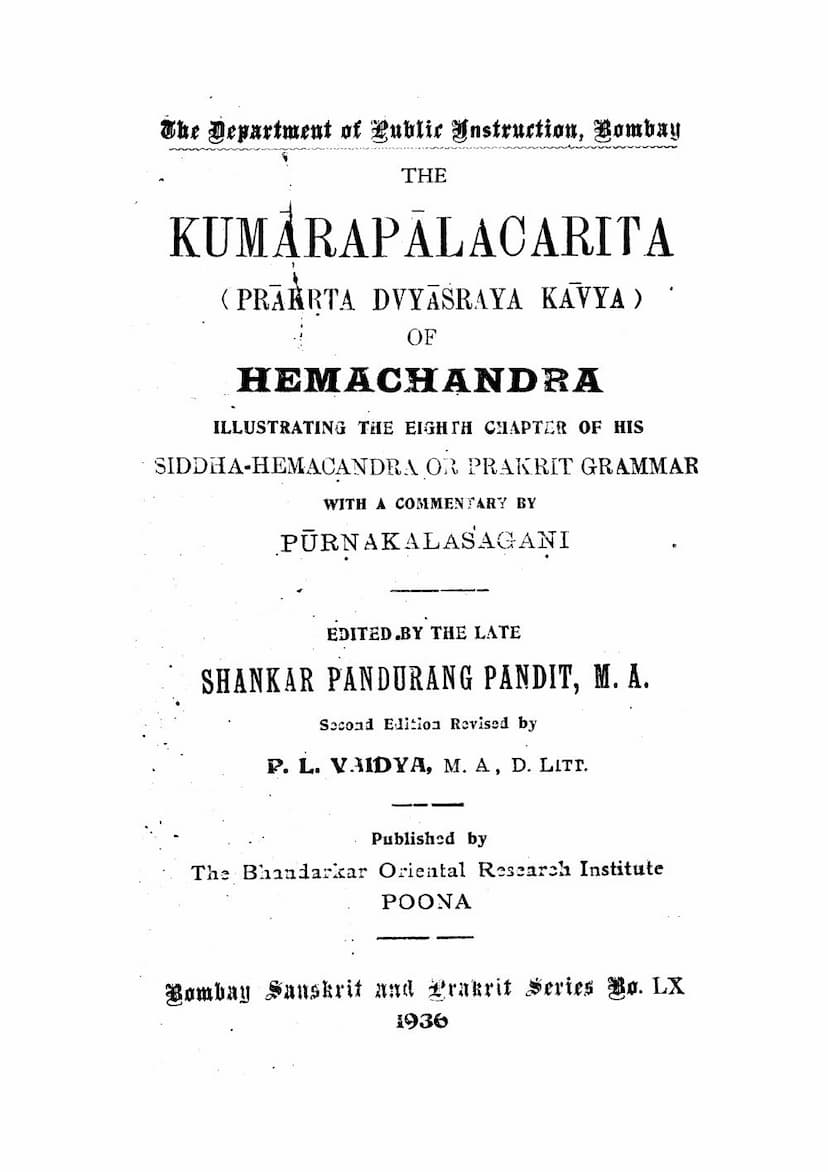Kumarpal Charita
Added to library: September 2, 2025

Summary
The Kumārapālacarita by Hemacandra, edited by Shankar Pandurang Pandit and revised by P. L. Vaidya, is a significant Jain text published by the Bhandarkar Oriental Research Institute. It is also known as the Prākrita Dvyāśraya Kavya.
This comprehensive work is structured in eight chapters (Adhyāyas). The Kumārapālacarita itself specifically illustrates the eighth chapter of Hemacandra's larger work, the Siddha-Hema-Śabdānuśāsana, which is a comprehensive grammar of Sanskrit and Prakrit languages. The Kumārapālacarita is an epic poem (Mahākāvya) written in Prakrit, with a commentary by Pūrṇakalaśagani.
Key aspects of the text include:
- Author: Hemacandra, a renowned Jain scholar, philosopher, and poet.
- Commentator: Pūrṇakalaśagani.
- Editor: Shankar Pandurang Pandit (first edition), P. L. Vaidya (second revised edition).
- Publisher: Bhandarkar Oriental Research Institute, Poona.
- Series: Bombay Sanskrit and Prakrit Series No. LX.
- Date of Publication: 1936 (second edition).
- Content: The Kumārapālacarita (Prākṛta Dvyāśraya Kāvyam) is a Prakrit epic poem that recounts the life and exploits of King Kumārapāla of Gujarat. It serves as a literary illustration of the Prakrit grammar rules contained in the eighth chapter of Hemacandra's Siddha-Hema-Śabdānuśāsana. The text is a valuable resource for understanding Prakrit language and Jain history.
Manuscript Material: The revised edition is based on manuscript material used for the first edition, which included three manuscripts for the Kumārapālacarita and its commentary, and one manuscript along with two printed editions for the eighth chapter of Hemacandra's Grammar. The text was written at different times and places, as detailed in the manuscripts, with some dating back to Samvat 1570 (1514 AD).
Significance of the Appendix: The appendix, containing the eighth chapter of the Siddha-Hema-Śabdānuśāsana, is highlighted as being extremely important for appreciating the Dvyāśraya kāvya and its commentary. It contains a significant portion of Hemacandra's grammar and his commentary (Vṛtti), providing crucial insights into the Prakrit dialects.
Structure of the Dvyāśraya Mahākāvya: The entire Dvyāśraya Mahākāvya consists of twenty cantos in Sanskrit and eight cantos in Prakrit. The first seven chapters of Hemacandra's Sūtras are illustrated by the Sanskrit portion, while the eighth chapter, focusing on the Prakrit language, is illustrated by the Kumārapālacarita.
Summary of the Hero and Author: The hero of the Kumārapālacarita is King Kumārapāla of Anahillapura (Pattana). The author of the poem and the grammar it illustrates is Hemacandra (also known as Hemācārya). The commentary on the Prakrit portion is by Pūrṇakalaśagani.
Life of King Kumārapāla: The introduction provides a detailed account of Kumārapāla's life, from his predicted sovereignty, his escape from Siddharāja, his encounters with a rat, his meeting with Hemacācarya, his coronation, and his reign. It mentions his patronage of Jainism, his prohibition of slaughter, and his pilgrimages. Kumārapāla was born in Samvat 1149 (1092 AD) and ascended the throne in Samvat 1199 (1142 AD). He died in Samvat 1229 (1172 AD) at the age of 80.
Life of Acarya Hemacandra: The introduction also includes a brief biography of Acarya Hemacandra, his birth, initiation into Jainism, his extensive scholarship, and his patronage by kings like Jayasimha (Siddharāja) and Kumārapāla. Hemacandra is described as a versatile writer whose works spanned various fields of knowledge. He died at the age of 84 in Samvat 1229 (1172 AD), shortly before Kumārapāla.
Content of the Kumārapālacarita (as described in the introduction): The poem begins with the description of the capital, Pattana, and Kumārapāla on the throne. It details the king's wealth, the grandeur of Jain temples, royal processions, and the king's devotion. It also narrates his warfare with Mallikārjuna, king of Konkan, and his relations with contemporary kings. The seventh and eighth cantos focus on moral and religious reflections, with the goddess Śrutadevi imparting wisdom to Kumārapāla, emphasizing virtues like patience, kindness, righteous conduct, and the control of passions, as well as the importance of the Pancha-Paramēṣṭhi-Namaskāra and non-violence.
Method of Recording Variants: The introduction also discusses the editor's method of recording variants from manuscripts, noting inconsistencies in Prakrit orthography, the use of anunāsika, and the substitution of certain letters.
In essence, the Kumārapālacarita is a meticulously edited and annotated work that provides a rich narrative of a significant Jain king's life, interwoven with the grammatical rules of Prakrit, making it a crucial text for both literary and linguistic studies within the Jain tradition.